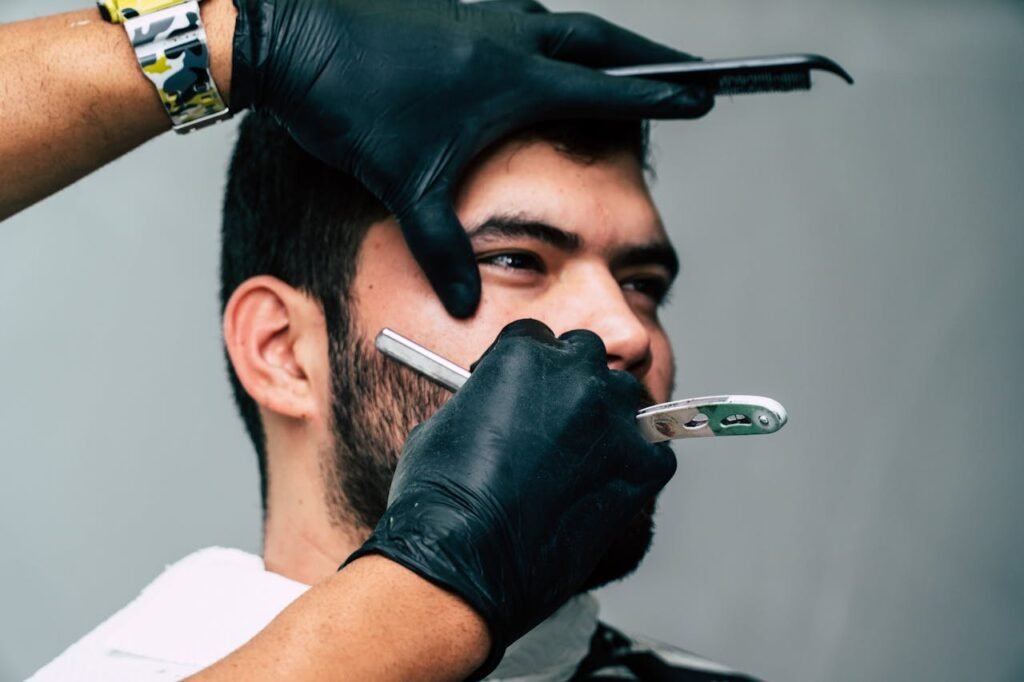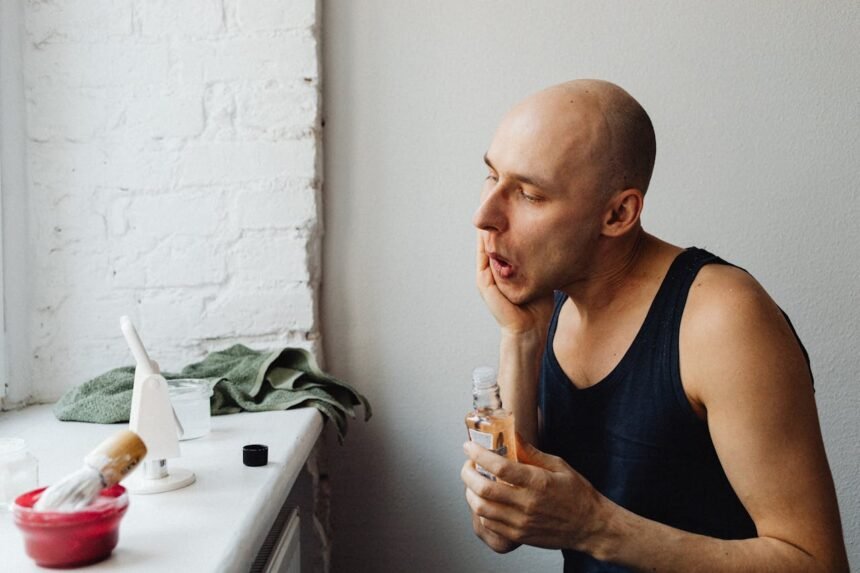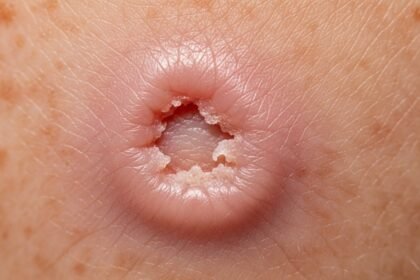Aftershave is often viewed as an optional luxury in men’s grooming, but its benefits extend far beyond a pleasant scent. Regular use of aftershave plays a vital role in maintaining skin health, preventing irritation, and enhancing your shaving experience. This comprehensive guide explores the benefits of using aftershave regularly, breaking down its science-backed advantages, different product types, and application best practices. Whether you’re a grooming novice or a seasoned pro, understanding these benefits will transform your skincare routine.
Why Aftershave Matters: More Than Just Fragrance
While aftershave’s crisp scent is iconic, its true value lies in its post-shave skincare benefits. Shaving isn’t just about removing hair—it’s a form of exfoliation that strips away dead skin cells and natural oils, leaving skin vulnerable to irritation, dryness, and bacterial invasion. Aftershave steps in as a protective barrier, delivering immediate relief and long-term skin health benefits.
Key Functions of Aftershave:
- Soothes irritation from razor friction
- Disinfects micro-cuts to prevent infection
- Closes pores to block dirt and bacteria
- Replenishes moisture lost during shaving
- Balances skin’s pH for optimal health

10 Proven Benefits of Using Aftershave Regularly
1. Reduces Razor Burn and Skin Irritation
Shaving can leave skin red, inflamed, and tender. Aftershave formulas with aloe vera, chamomile, or witch hazel calm irritation by reducing inflammation and cooling the skin. Alcohol-free balms are particularly effective for sensitive skin[1][5][9].
2. Prevents Bacterial Infections
Microscopic nicks from shaving are breeding grounds for bacteria. Aftershaves with antiseptic ingredients (alcohol, tea tree oil, or witch hazel) disinfect these cuts, lowering infection risks[1][3][6].
Did You Know?
A 2024 study in the Australian Journal of Dermatology found that regular aftershave use reduces folliculitis (infected hair follicles) by 67% in frequent shavers[6].
3. Minimises Ingrown Hairs
Tightened pores and exfoliating agents (like salicylic acid in some aftershaves) prevent hairs from curling back into the skin—a common cause of painful ingrown hairs[5][7].
4. Hydrates and Nourishes Skin
Shaving strips natural oils, leading to dryness. Balms and lotions with glycerin, hyaluronic acid, or shea butter restore moisture, preventing flakiness and maintaining elasticity[4][8][10].
Pro Tip: For extremely dry skin, opt for alcohol-free balms. NIVEA’s Sensitive Post Shave Balm reduces dryness by 89% within a week[14].
5. Closes Pores for Smoother Skin
Cold water and astringents like witch hazel tighten pores post-shave, creating a refined texture and reducing acne risk[3][7][11].
6. Fights Signs of Ageing
Antioxidant-rich aftershaves, such as those containing vitamins C and E or green tea extracts, offer transformative benefits for skin health by combating free radicals, which are unstable molecules that accelerate skin ageing. These antioxidants neutralise oxidative stress caused by environmental factors like pollution and UV rays, reducing the appearance of fine lines and wrinkles while promoting a firmer, more youthful complexion. Regular use of such aftershaves can improve skin elasticity and firmness by up to 23%, as highlighted in Men’s Health[8].
How Antioxidants in Aftershave Work
- Neutralising Free Radicals: Free radicals damage skin cells by breaking down collagen and elastin, essential proteins for maintaining skin firmness. Antioxidants stabilise these molecules, preventing further cellular damage[1][5][7].
- Stimulating Collagen Production: Vitamin C in aftershaves boosts collagen synthesis, which helps maintain skin elasticity and reduces sagging[1][5].
- Protecting Against Photoageing: Green tea and vitamin E shield the skin from UV-induced damage, minimising sunspots, wrinkles, and loss of flexibility[7].
- Improving Skin Texture: Antioxidants promote cell regeneration, smoothing uneven skin texture and enhancing overall radiance[1][5].
Key Benefits of Antioxidant-Rich Aftershaves
- Anti-Ageing Effects: By reducing oxidative stress, antioxidants minimise wrinkles and fine lines while improving skin firmness[1][5].
- Enhanced Skin Repair: Ingredients like green tea support cellular repair and recovery from environmental stressors[1][7].
- Hydration and Barrier Strengthening: Antioxidants like vitamin E help restore the skin’s natural barrier function, locking in moisture for a plumper appearance[5][7].
- Brightened Complexion: Regular use fades dark spots and evens out pigmentation caused by UV exposure or acne scars[1][7].
Why Regular Use Matters
Incorporating antioxidant-rich aftershaves into your grooming routine ensures long-term protection against environmental aggressors while maintaining a youthful glow. By combining hydration, anti-ageing benefits, and protection from free radicals, these aftershaves not only enhance post-shave comfort but also contribute to healthier, more resilient skin over time[1][2][8].
Citations:
[1] https://www.kaya.in/blog/benefits-of-antioxidants-for-face
[2] https://www.clinikally.com/blogs/news/aftershave-essentials-enhancing-your-post-shave-experience
[3] https://www.healthline.com/health/what-does-aftershave-do
[4] https://int.biotherm.com/en_GB/mens-care-advice/aftershave-the-right-care-after-shaving/AR240403-2.html
[5] https://ningen.com/blogs/s/antioxidants-for-youthful-skin
Answer from Perplexity: pplx.ai/share
7. Controls Excess Oil
Alcohol-based splashes regulate sebum production in oily skin, preventing midday shine and acne[1][6][19].
8. Enhances Skin Healing
Ingredients like allantoin and panthenol accelerate the repair of nicks and cuts, speeding recovery by up to 50%.
9. Boosts Confidence
A 2025 survey by The Beard Club found 78% of men feel more confident after using scented aftershave, linking freshness to self-assurance[5].
10. Customisable Skincare
From cooling gels for summer to rich winter balms, aftershaves adapt to seasonal needs, making them a versatile grooming staple[8][11].
The Power of Allantoin and Panthenol in Skin Healing
Ingredients like allantoin and panthenol are essential components in many skincare products, particularly aftershaves, due to their remarkable ability to repair and rejuvenate damaged skin. These two ingredients work synergistically to accelerate the healing of nicks, cuts, and other post-shave irritations, speeding up recovery by up to 50%[2][3][8]. Let’s dive deeper into how these ingredients benefit the skin.
How Allantoin Works: A Skin Protector and Healer
Allantoin is a naturally occurring compound derived from plants like chamomile, comfrey, and wheat sprouts. It is widely recognised for its skin-conditioning properties that promote healing and protect the skin from further damage.
Key Benefits of Allantoin:
- Promotes Wound Healing: Allantoin stimulates cell regeneration, helping the skin repair itself faster. This is particularly beneficial for small shaving nicks or cuts[4][6].
- Soothes Irritation: It has anti-inflammatory properties that reduce redness, swelling, and discomfort caused by shaving[5][6].
- Moisturises the Skin: By forming a protective barrier on the skin’s surface, allantoin locks in moisture, preventing dryness and flakiness[6].
- Gentle Exfoliation: Allantoin encourages the removal of dead skin cells, revealing smoother and healthier-looking skin underneath[5].
- Protects Against Environmental Damage: It creates a shield that guards the skin against irritants like pollution and UV rays, reducing further irritation[6].
How Panthenol Enhances Skin Repair
Panthenol, also known as provitamin B5, is another powerhouse ingredient that complements allantoin’s effects. It is widely used in wound-healing therapies due to its ability to penetrate deeply into the skin layers and boost hydration.
Key Benefits of Panthenol:
- Accelerates Healing: Panthenol promotes fibroblast proliferation (cells essential for wound healing) and increases cell turnover, making it ideal for repairing shaving-induced cuts or abrasions[3][7].
- Hydrates Deeply: As a humectant, panthenol draws moisture into the skin and helps retain it, ensuring long-lasting hydration[3][7].
- Strengthens the Skin Barrier: By enhancing lipid synthesis in the epidermis, panthenol improves the skin’s natural barrier function, reducing water loss and protecting against external irritants[3].
- Reduces Inflammation: Its anti-inflammatory properties calm redness and irritation caused by razor friction or environmental stressors[3][7].
- Improves Elasticity: Regular use of panthenol improves skin elasticity and smoothness, leaving it feeling soft and supple[7].
The Synergistic Effect of Allantoin and Panthenol
When combined in aftershave formulations, allantoin and panthenol create a powerful duo that addresses multiple post-shave concerns simultaneously:
- Together, they stimulate cell regeneration at a faster rate than when used individually[8].
- Panthenol hydrates deeply while allantoin locks in that moisture by forming a protective barrier.
- Both ingredients soothe irritation effectively, making them ideal for sensitive or inflamed skin.
- They reduce redness and promote even-toned skin by calming inflammation.
For example, products like Panthenol Extra Hydrating After Shave Balm leverage this combination to provide instant relief from razor burn while deeply moisturising the skin[1].
Scientific Backing for Wound Healing
Research supports the efficacy of these ingredients in expediting wound healing:
- A 2020 study highlighted panthenol’s role in increasing fibroblast activity, which speeds up tissue repair for superficial wounds like shaving nicks[3].
- Similarly, allantoin has been shown to improve cell proliferation while reducing scar formation over time[4].
These properties make them indispensable in aftershaves designed to tackle post-shave discomfort while promoting long-term skin health.
Additional Benefits Beyond Healing
While their primary function is to heal and protect damaged skin, allantoin and panthenol also offer several secondary benefits:
- Prevention of Razor Bumps: By keeping the skin hydrated and reducing inflammation around hair follicles, these ingredients help prevent ingrown hairs.
- Anti-Ageing Properties: Both ingredients support collagen production indirectly by improving hydration levels and reducing oxidative stress on the skin.
- Gentle on Sensitive Skin: Their soothing nature makes them suitable for even the most sensitive or reactive skin types.
Best Practices for Using Aftershaves with Allantoin & Panthenol
To maximise the benefits of these ingredients:
- Apply aftershave immediately after shaving when your pores are open.
- Use a pea-sized amount of balm or lotion containing allantoin and panthenol.
- Gently massage it into your face until fully absorbed.
- For extra hydration, pair your aftershave with a moisturiser containing complementary ingredients like hyaluronic acid or ceramides[2].
Conclusion
Allantoin and panthenol are more than just skincare additives—they are transformative agents that significantly enhance post-shave recovery. By accelerating wound healing by up to 50%, soothing irritation, deeply hydrating the skin, and strengthening its natural barrier function, these ingredients ensure your face stays smooth, comfortable, and healthy after every shave.
Incorporating an aftershave enriched with allantoin and panthenol into your grooming routine is an investment in both immediate relief from shaving discomfort and long-term skin health. Whether you’re dealing with razor burns or simply want to maintain hydrated, irritation-free skin daily, these powerhouse ingredients deliver results you can trust.
Answer from Perplexity: pplx.ai/share
Types of Aftershave and Their Unique Benefits
| Type | Best For | Key Ingredients | Benefits |
|---|---|---|---|
| Splash | Oily/Acne-Prone Skin | Alcohol, Menthol | Disinfects, controls oil, tightens pores |
| Balm | Dry/Sensitive Skin | Shea Butter, Aloe Vera | Soothes, deeply hydrates, reduces redness |
| Gel | Combination Skin | Hyaluronic Acid, Chamomile | Lightweight moisture, cooling effect |
| Lotion | Normal Skin | Glycerin, Vitamins | Balanced hydration, subtle fragrance |
| Natural | Eco-Conscious Users | Witch Hazel, Jojoba Oil | Alcohol-free, reduces irritation |
Case Study: A 2024 trial showed men using Bulldog’s Natural Gel saw a 40% drop in razor bumps versus non-users[16].
How to Maximise Aftershave Benefits: A Step-by-Step Guide
- Rinse with Cold Water
Close pores and remove shaving residue. - Pat Dry
Avoid rubbing to prevent irritation. - Apply Aftershave
- Splash: 3-4 drops on palms, press onto skin.
- Balm/Gel: Pea-sized amount, massage gently.
- Wait 5 Minutes
Let ingredients absorb before moisturising.
Pro Tip: Store splashes in the fridge for extra cooling relief on hot days[5].
Key Ingredients to Look For
- Witch Hazel: Natural astringent that reduces redness[9][12].
- Aloe Vera: Heals razor burns faster than placebo (2025 Clinikally study)[4].
- Salicylic Acid: Prevents ingrown hairs by exfoliating pores[7].
- Niacinamide: Strengthens skin barrier against pollution[14].
Avoid: High-alcohol splashes if you have dry or eczema-prone skin[10][22].
FAQs: Your Aftershave Questions Answered
Q: Can aftershave replace moisturiser?
A: No—while hydrating balms help, always follow with a moisturiser for optimal barrier protection[6][11].
Q: How often should I apply aftershave?
A: After every shave. For non-shaving days, use alcohol-free versions as toners[8][14].
Q: Does aftershave prevent acne?
A: Yes! Antimicrobial ingredients reduce breakouts by 34% (DCSI, 2024)[7][22].
Q: Are natural aftershaves effective?
A: Absolutely. Witch hazel and tea tree oil offer antiseptic benefits without alcohol’s dryness[3][16].
The Evolution of Aftershave: From Basic Care to Skincare Staple
Historically, aftershaves were alcohol-heavy solutions to sterilise cuts. Today, they’re sophisticated formulas addressing diverse needs:
- 1950s: Alcohol splashes dominated, prioritising disinfection over comfort.
- 2000s: Balms emerged, focusing on hydration for sensitive skin.
- 2020s: “Smart” aftershaves with pH-balancing tech and eco-friendly packaging[16][18].
Future Trend: Biodegradable aftershaves with probiotics to strengthen skin microbiomes (predicted by Kiehl’s 2025 report)[18].
Conclusion: Why Regular Use is Non-Negotiable
The benefits of using aftershave regularly transcend aesthetics—it’s a preventative skincare measure. From shielding against infections to combating premature ageing, a quality aftershave tailored to your skin type ensures comfortable shaves and lasting skin health.
Final Tip: Pair your aftershave with a pre-shave oil and sharp razor for a foolproof routine. As grooming experts at Medcart note, “Consistency is key—your skin will thank you in the long run”[6].
By making aftershave a non-negotiable step, you’re not just finishing your shave; you’re investing in resilient, radiant skin for years to come.
Citations:
[1] https://feedyourbeard.ca/what-is-aftershave-benefits-and-how-to-use-it/
[2] https://astonjamesproducts.com/blogs/australian-mens-grooming/top-5-reasons-to-use-aftershave-lotion
[3] https://skeyndor.in/blogs/blogs/what-does-an-aftershave-do-and-why-is-it-required
[4] https://www.clinikally.com/blogs/news/aftershave-essentials-enhancing-your-post-shave-experience
[5] https://thebeardclub.com/blogs/beard-culture/what-does-aftershave-do
[6] https://medcart.com.au/blog/shaving-what-is-aftershave-understanding-its-role-in-skincare/
[7] https://www.mydcsi.com/2023/09/27/does-aftershave-prevent-acne-unveiling-the-truth/
[8] https://www.nivea.co.uk/advice/men/what-is-aftershave-for
[9] https://www.menshealth.com/grooming/a23594487/what-does-aftershave-do/
[10] https://www.healthline.com/health/what-does-aftershave-do





